Community resources
Community resources
- Community
- Products
- Jira Align
- Articles
- What is Jira Align and the difference between Jira Standard and Jira align
What is Jira Align and the difference between Jira Standard and Jira align
Hi Community,
This is Wednesday again, and Weekly knowledge growth with Jira Guru!
Today's topic is "Jira Align"
------
What is Jira Standard?
Jira Standard or Jira is a versatile project management tool designed to help teams plan, track, and manage their work efficiently. It is widely used by teams of all sizes to handle everything from simple task management to complex project tracking. Here are some of the key features that make Jira Standard a popular choice:
- Project Tracking and Management: Keep track of all your projects in one place, with customizable workflows that fit your team's unique processes.
- Issue and Bug Tracking: Identify, report, and resolve issues quickly with robust bug tracking capabilities.
- Agile Boards: Utilize Scrum and Kanban boards to manage your team's workload and ensure projects stay on track.
- Reporting and Dashboards: Access real-time insights with customizable dashboards and reports to monitor progress and performance.
- Integration: Seamlessly integrate with other Atlassian tools like Confluence and Bitbucket, as well as a wide range of third-party apps.

source: atlassian
What is Jira Align?
Jira Align takes project management to the next level, providing enterprises with the tools they need to align strategy with execution. It bridges the gap between business strategy and technical execution, ensuring that all teams are working towards common goals. Here are some of the standout features of Jira Align:
- Enterprise-Level Project Management: Manage multiple teams, portfolios, and programs with ease, ensuring alignment across the entire organization.
- Strategic Alignment and Planning: Connect strategic goals with execution by visualizing dependencies and aligning work with business objectives.
- Comprehensive Reporting and Analytics: Gain deep insights with advanced analytics and customizable reports, helping you make data-driven decisions.
- Integration: Integrate seamlessly with multiple Jira instances and other enterprise tools, ensuring a cohesive workflow across different teams and departments.
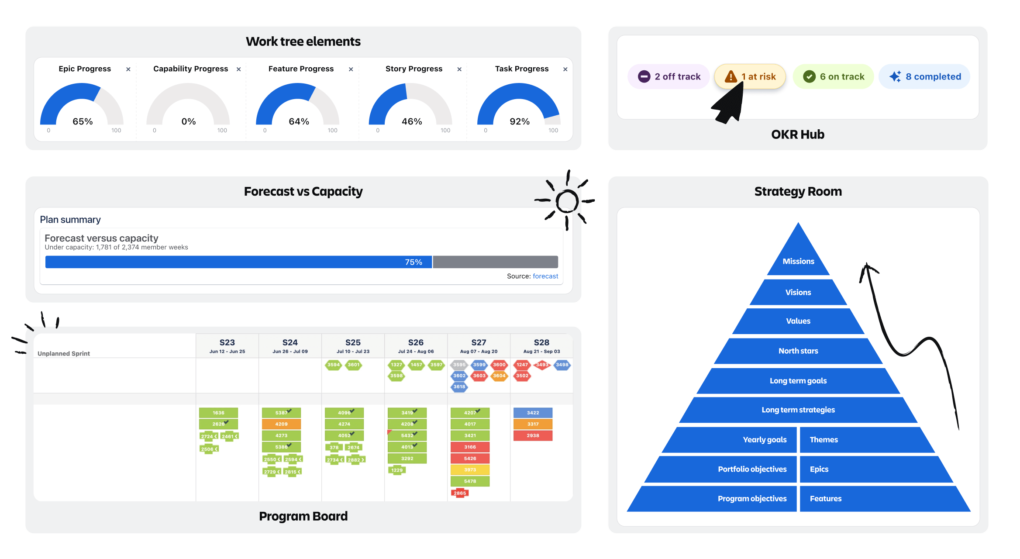
source: atlassian
Key Differences Between Jira Standard and Jira Align
To help you better understand the distinct features and capabilities of Jira Standard and Jira Align, let's explore the key differences between the two:
| Aspect | Jira Standard | Jira Align |
| Target Audience | Teams and small to medium-sized businesses | Large enterprises with complex project management needs |
| Scalability | Team-level management | Enterprise-level management with multiple teams, portfolios, and programs |
| Features and Capabilities | Basic project management and agile features | Advanced features for strategic planning, portfolio management, and cross-team collaboration |
| Project Tracking | Supports project and issue tracking | Comprehensive tracking across teams, programs, and portfolios |
| Agile Boards | Scrum and Kanban boards | Scaled agile frameworks like SAFe, LeSS, and more |
| Strategic Planning | Limited to team-level planning | Aligns business strategy with execution, visualizing dependencies and outcomes |
| Reporting and Analytics | Basic reporting and dashboards | Advanced analytics, real-time insights, and customizable reports |
| Resource Management | Basic resource management capabilities | Advanced resource planning and allocation across the organization |
| Dependency Management | Limited to team-level dependencies | Manages dependencies across multiple teams and projects |
| Roadmapping | Basic roadmaps | Comprehensive roadmaps linking strategy to execution |
| Integration and Connectivity | Integrates with Atlassian tools and third-party apps | Seamless integration with multiple Jira instances and other enterprise tools |
| Customization | Custom workflows, fields, and screens | Highly customizable to fit enterprise needs, including custom dashboards and reports |
| User Management | Basic user roles and permissions | Advanced role-based access control and user management |
| Portfolio Management | Not available | Extensive portfolio management features, including financial tracking and value stream mapping |
| Cost and Pricing | More affordable, suitable for smaller budgets | Higher cost, justified by advanced features and enterprise-level support |
| Implementation | Easier and quicker to implement | More complex implementation, often requiring professional services or consulting |
| Support and Training | Standard support and community resources | Enhanced support options, including dedicated account managers and training programs |
Use Cases and Scenarios
When to Use Jira Standard
1. Small to Medium-Sized Teams
- Scenario: A marketing team of 10 people needs to manage their campaigns, track tasks, and collaborate on projects.
- Use Case: Jira Standard provides the tools they need to create and manage tasks, use agile boards for planning, and generate basic reports to track progress.
2. Agile Development Teams
- Scenario: A software development team following Scrum practices needs a tool to manage their sprints, backlogs, and releases.
- Use Case: Jira Standard’s Scrum boards, sprint planning features, and integration with development tools like Bitbucket make it ideal for this team.
3. Basic Project Management
- Scenario: A small business needs to manage various internal projects, such as office renovations or product launches.
- Use Case: Jira Standard offers a straightforward solution with customizable workflows, issue tracking, and dashboards to keep projects on track.
4. Entry-Level Agile Adoption
- Scenario: An organization is starting to adopt agile methodologies and needs a tool to help transition from traditional project management.
- Use Case: Jira Standard’s user-friendly interface and agile features provide a smooth transition and help teams adapt to new processes.
When to Use Jira Align
1. Large Enterprises with Complex Project Management Needs
- Scenario: A multinational corporation needs to manage multiple projects across different departments and geographies.
- Use Case: Jira Align provides the scalability and advanced features necessary to manage complex projects, align cross-functional teams, and ensure strategic goals are met.
2. Strategic Portfolio Management
- Scenario: An enterprise wants to ensure that all projects and initiatives align with the company's strategic objectives.
- Use Case: Jira Align’s portfolio management capabilities allow the organization to track and manage projects at a strategic level, ensuring alignment with business goals.
3. Scaled Agile Frameworks
- Scenario: A technology company with multiple agile teams needs to coordinate work across teams and adopt a scaled agile framework like SAFe.
- Use Case: Jira Align supports frameworks such as SAFe and LeSS, enabling the company to implement and manage scaled agile practices effectively.
4. Advanced Reporting and Analytics
- Scenario: A financial services firm requires detailed analytics and reporting to comply with regulatory requirements and improve decision-making.
- Use Case: Jira Align offers comprehensive reporting and analytics tools that provide deep insights into project performance and resource utilization.
5. Resource and Dependency Management
- Scenario: A manufacturing company needs to manage resources across various projects and ensure that dependencies between teams do not cause delays.
- Use Case: Jira Align’s advanced resource and dependency management features help the company optimize resource allocation and manage dependencies effectively.
6. Organizational Change and Transformation
- Scenario: An organization is undergoing a digital transformation and needs to align its IT and business teams to deliver new capabilities.
- Use Case: Jira Align provides the tools to connect strategic objectives with execution, ensuring that transformation initiatives are aligned and executed efficiently.
How Enterprises Thrive with Jira Align
Enterprises can achieve remarkable success by leveraging the advanced capabilities of Jira Align. Here are several ways in which Jira Align helps large organizations thrive:
1. Strategic Alignment and Planning
Jira Align bridges the gap between business strategy and technical execution, ensuring that all teams are working towards common organizational goals. By providing a clear line of sight from strategic objectives to team-level tasks, enterprises can ensure that every effort is aligned with the company’s vision and mission.
- Visibility: Gain a comprehensive view of how work at every level contributes to strategic goals.
- Prioritization: Prioritize initiatives that deliver the most value to the business.
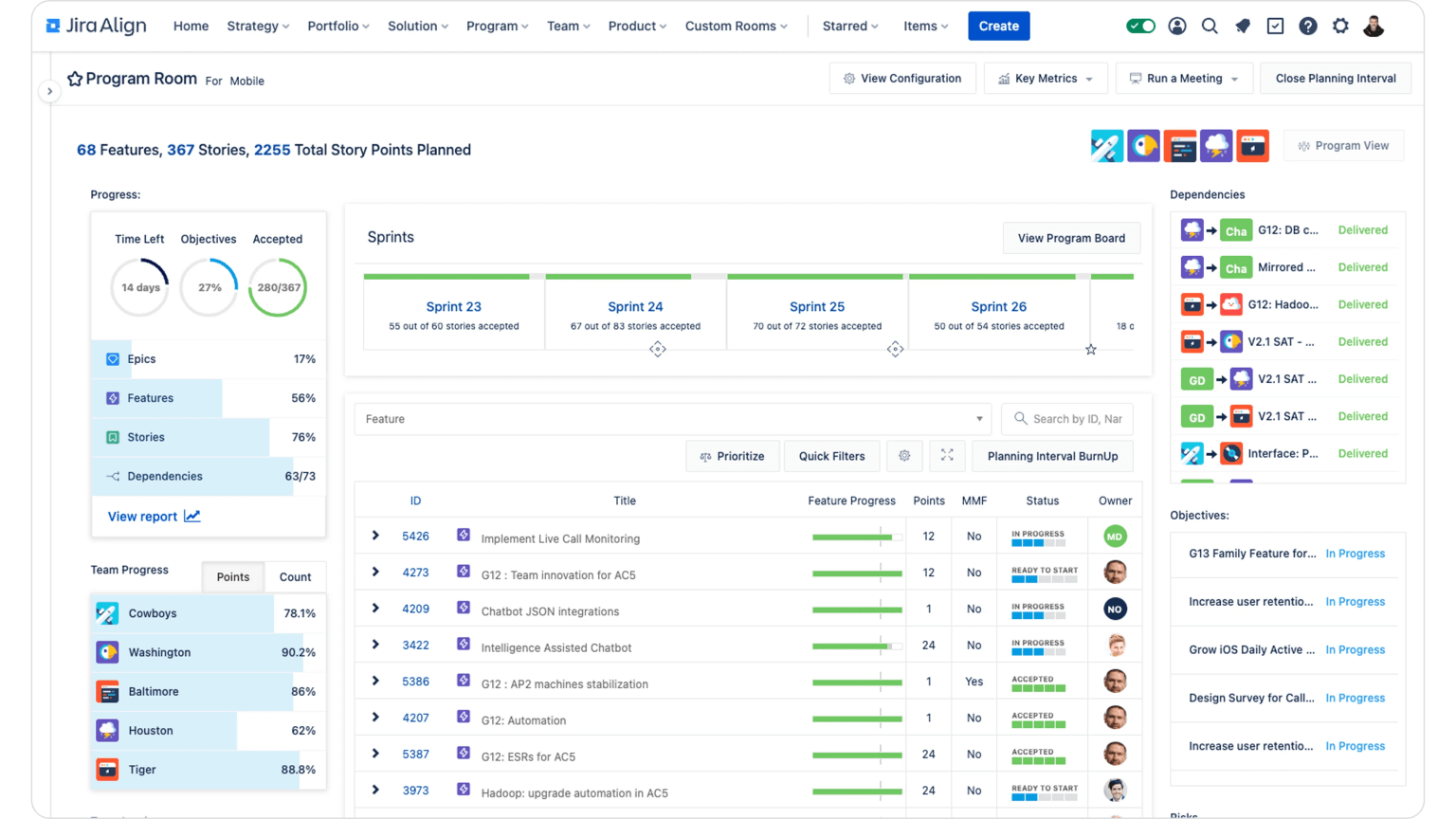
2. Enhanced Collaboration and Communication
With Jira Align, cross-team collaboration is streamlined, breaking down silos and fostering better communication across departments. This leads to more efficient workflows and improved project outcomes.
- Unified Platform: Teams across the organization use a single platform, ensuring everyone is on the same page.
- Real-Time Updates: Stakeholders receive real-time updates, reducing the risk of miscommunication.
3. Advanced Reporting and Analytics
Jira Align offers powerful reporting and analytics tools that provide deep insights into project performance and resource utilization. This enables data-driven decision-making, helping enterprises optimize their processes and improve efficiency.
- Customizable Reports: Tailor reports to meet specific needs and gain insights into critical metrics.
- Predictive Analytics: Use historical data to forecast future trends and make proactive adjustments.
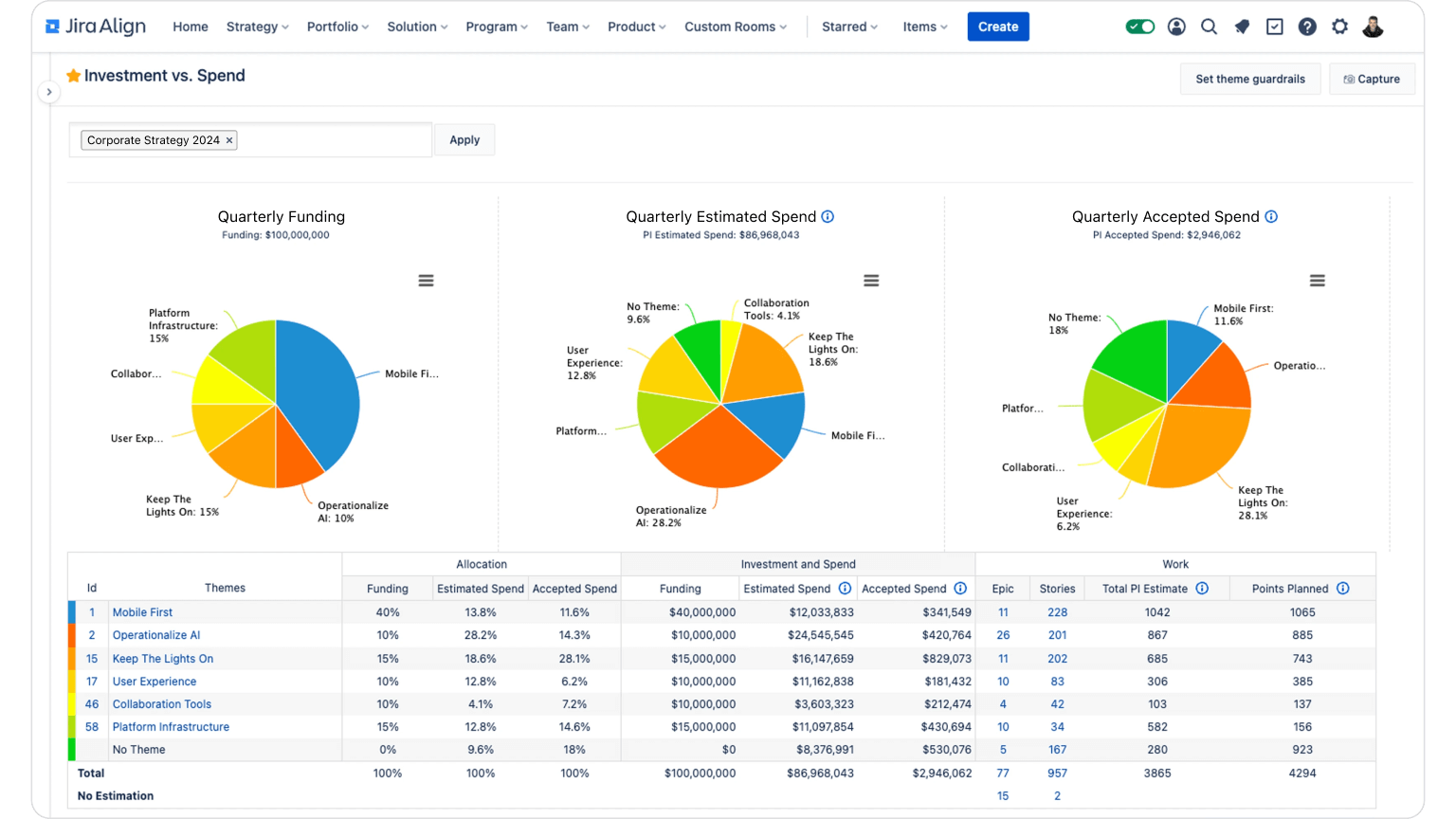
4. Scalable Agile Frameworks
Jira Align supports various scaled agile frameworks, such as SAFe (Scaled Agile Framework), LeSS (Large Scale Scrum), and others. This flexibility allows enterprises to adopt the framework that best fits their unique requirements and scale agile practices across the entire organization.
- Framework Support: Choose from multiple frameworks to implement agile at scale.
- Best Practices: Incorporate industry best practices to enhance agile transformation.
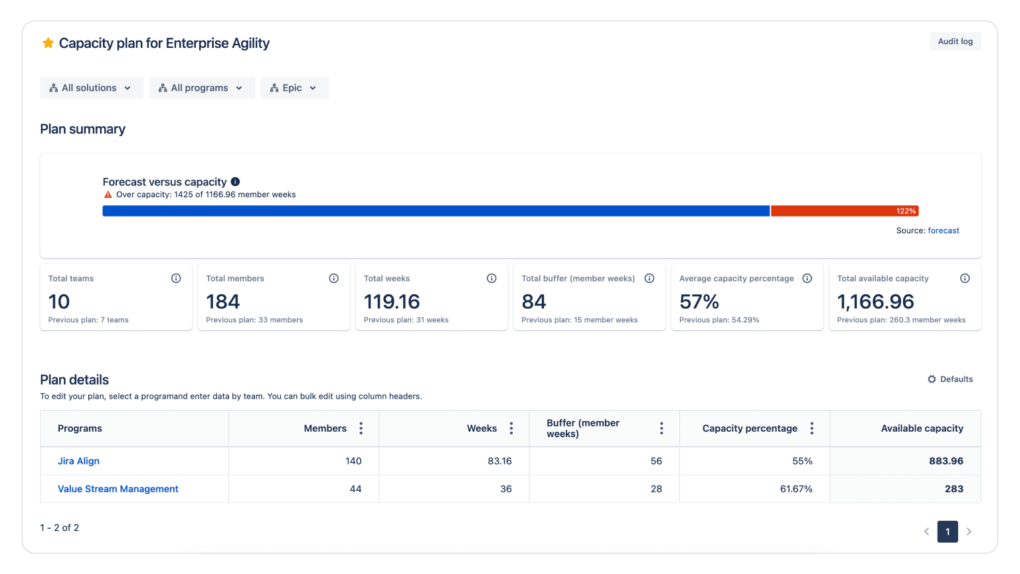
5. Resource and Dependency Management
Effective resource management is critical for large enterprises. Jira Align provides advanced tools to manage resources and dependencies, ensuring that the right people are working on the right tasks at the right time.
- Resource Allocation: Optimize resource allocation to maximize productivity and minimize bottlenecks.
- Dependency Tracking: Identify and manage dependencies across teams and projects to prevent delays.
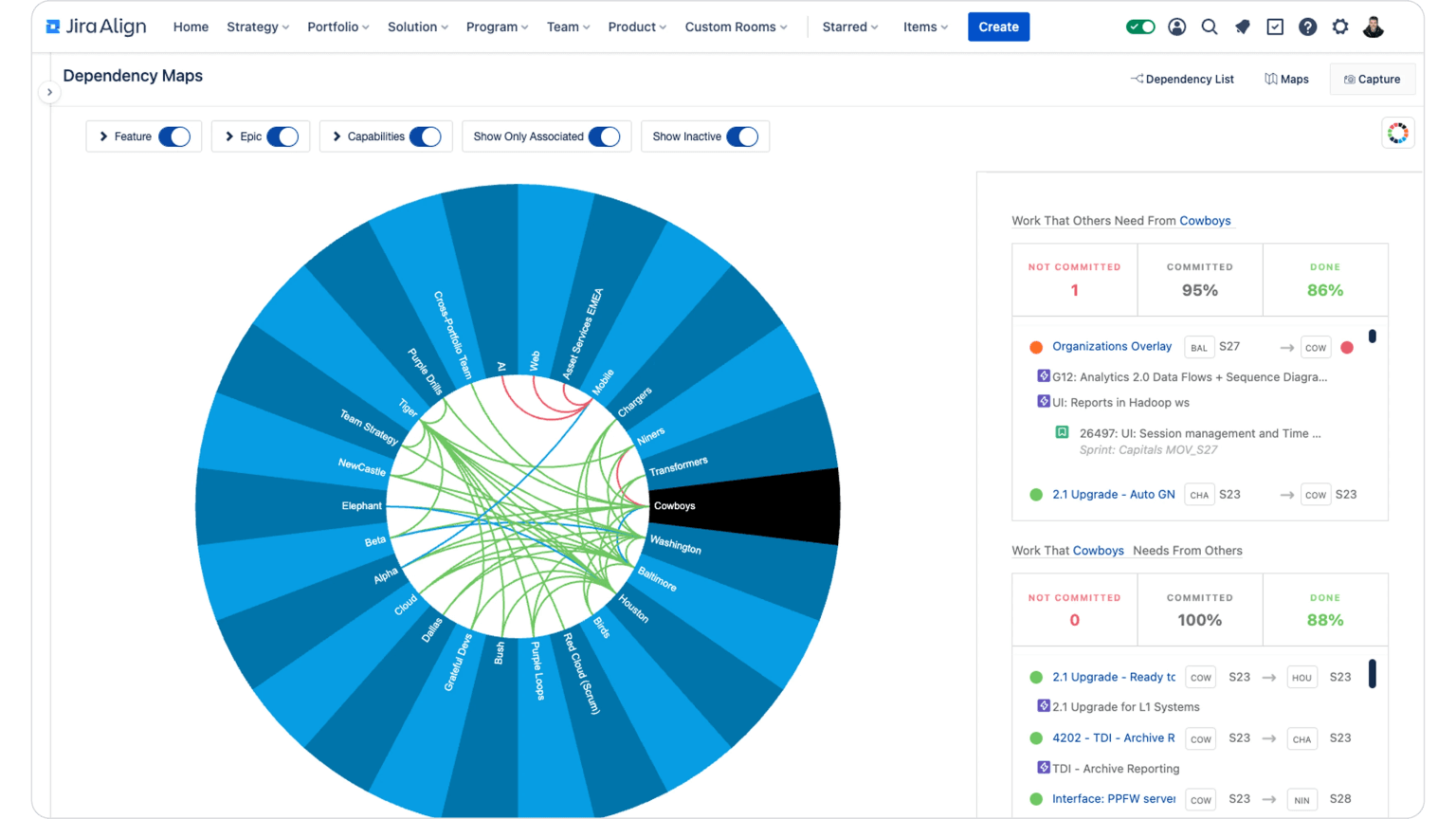
6. Improved Financial Tracking and ROI
Jira Align allows enterprises to track financials at a granular level, linking expenditures to specific projects and initiatives. This transparency helps in understanding the return on investment (ROI) and making informed financial decisions.
- Financial Visibility: Monitor costs and budgets across all initiatives.
- ROI Measurement: Evaluate the ROI of projects to ensure strategic investments are paying off.
7. Adaptability and Continuous Improvement
Jira Align enables enterprises to be more adaptable and responsive to change. By continuously monitoring progress and adjusting plans as needed, organizations can stay agile and competitive in a rapidly changing business environment.
- Continuous Feedback: Gather continuous feedback to improve processes and outcomes.
- Agility: Quickly adapt to changes in the market or business priorities.
Get in touch to get started with Jira Align
Conclusion
In summary, both Jira Standard and Jira Align are powerful tools that serve different purposes. Jira Standard is perfect for teams and small to medium-sized businesses looking for a robust, agile project management solution. In contrast, Jira Align is ideal for large enterprises that need to align strategy with execution across multiple teams and portfolios.
If you’re still unsure which tool is right for you, take the time to evaluate your project management requirements and consider the unique needs of your organization. For more detailed information, check out the official pages for Jira Standard and Jira Align, and don’t hesitate to reach out for a consultation.
Was this helpful?
Thanks!
Teresa_DevSamurai
About this author
Product Marketing
DevSamurai
27 accepted answers

4 comments